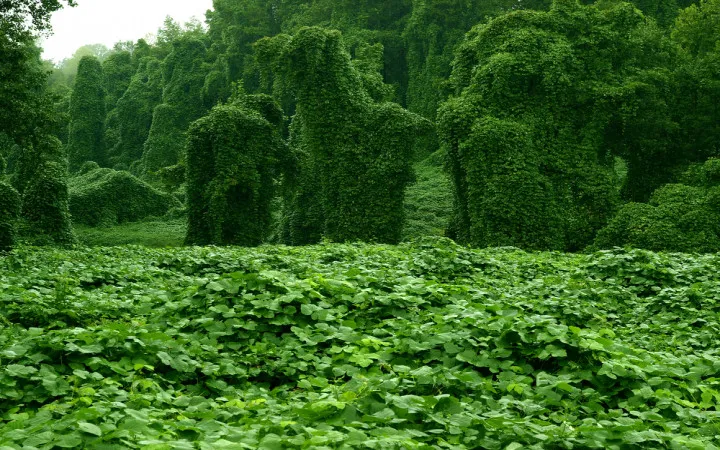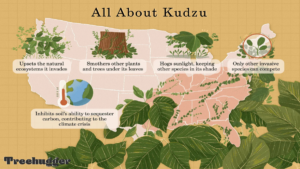Is kudzu strangling your yard? Learn what this invasive vine is, why it’s a problem, and the best ways to control kudzu on your property.
Introduction: Kudzu Vine
If you live in the southeastern United States, chances are you’ve seen kudzu. This incredibly fast-growing vine can smother entire landscapes, earning it the nickname “the vine that ate the South.” You might be wondering, how did this invasive plant get here? How do you get rid of it? And is it all bad? Keep reading to find out everything you need to know about kudzu.
What is Kudzu?
Kudzu (Pueraria montana var. lobata) is a climbing, perennial vine in the pea family. It’s native to Asia and was introduced to the United States in the late 1800s. Kudzu has large leaves and can grow up to a foot a day during the summer! Its roots are massive and starchy, allowing it to survive harsh conditions.
Understanding Kudzu: A Historical Overview
Why Did Farmers Plant Kudzu?
Farmers were encouraged to plant kudzu in the early 20th century by the Soil Erosion Service to combat severe soil erosion problems exacerbated by poor agricultural practices and deforestation. The vine was also used to stabilize soil and add nitrogen, improving the fertility of the soil.
What Was the Kudzu Vine Used For?
Kudzu has been utilized for various purposes, including soil erosion control, animal fodder, and even medicinal uses. In traditional Chinese medicine, it has been used to treat alcoholism and menopausal symptoms, among other conditions.

The Harmful Impact of Kudzu
Why Is the Kudzu Vine Harmful?
Kudzu is harmful because it grows rapidly and can overtake native vegetation, leading to a decrease in biodiversity. It smothers other plants and trees by blocking sunlight, essentially killing them. Additionally, kudzu can damage structures and has been known to pull down power lines due to its weight.
Why Is Kudzu Not a Problem in Japan?
In its native environment in Japan, kudzu is managed by natural predators and a balanced ecosystem that keeps its growth in check. The presence of certain insects and diseases that specifically target kudzu helps prevent it from becoming as invasive as it is in the US.
Legal and Culinary Aspects of Kudzu
Is Planting Kudzu Illegal?
Yes, in many places in the US, planting kudzu is illegal because it is classified as a noxious weed. This classification means it is recognized as harmful to agricultural or ecological regions.
Can Kudzu Be Eaten?
Yes, various parts of the kudzu plant, such as leaves, roots, and flowers, are edible. The roots can be used to make starch and the leaves are often used in salads or cooked as greens.
What Animals Eat Kudzu?
Kudzu is palatable to many grazing animals, including goats and cattle. These animals can help control kudzu by eating the leaves and vines, which can prevent the plant from spreading.
Why Kudzu Thrives: An In-Depth Look
Why Is Kudzu So Successful?
Kudzu is highly successful due to its robust growth rate, ability to thrive in a variety of soil conditions, and its deep root system that helps it survive in diverse environments. Its rapid growth allows it to outcompete native species quickly.
Why Do People Take Kudzu?
People take kudzu primarily for its medicinal properties. It has been used to treat alcohol dependency, menopausal symptoms, and more. Its high isoflavone content is thought to offer various health benefits, though more research is needed to fully understand its efficacy.
How does kudzu affect the environment?
Kudzu, a fast-growing vine native to Asia, significantly impacts the environment in various detrimental ways, particularly in regions where it has been introduced, such as the United States.
Ecological Impacts
- Outcompetition of Native Species:
Kudzu aggressively outcompetes native flora by growing over them and depriving them of essential sunlight needed for photosynthesis. This not only reduces biodiversity but also disrupts local ecosystems. - Formation of Monocultures:
Due to its rapid growth and ability to thrive in low-nitrogen soils, kudzu often forms dense, monospecific stands that dominate landscapes and displace diverse plant communities. This results in significant alterations to the structure and function of native plant communities. - Damage to Trees and Forests:
Kudzu vines can envelop trees, blocking sunlight and adding significant weight, which can lead to tree falls, especially during storms. This smothering effect can weaken and eventually kill affected trees, leading to further ecological imbalance.
Environmental Degradation
- Soil Erosion:
Contrary to its initial use for erosion control, kudzu can exacerbate soil erosion problems. While it initially stabilizes soil with its roots, the eventual death of smothered native vegetation under dense kudzu growth can lead to a lack of ground cover, making areas more susceptible to erosion. - Alteration of the Nitrogen Cycle:
As a nitrogen-fixing plant, kudzu alters nitrogen cycling in the soil. This can affect soil fertility and the overall nutrient dynamics of the ecosystems it invades, which may have long-term impacts on plant growth and soil health.
Impact on Air Quality
- Contribution to Ozone Pollution:
Kudzu emits isoprene, a volatile organic compound that can react with other pollutants under sunlight to form ozone, a harmful air pollutant. Studies have shown that kudzu significantly contributes to increased ozone levels, which can exacerbate respiratory problems and other health issues in humans, as well as harm other plant species. - Release of Carbon Dioxide:
Kudzu invasions can lead to increased decomposition rates of soil organic matter, releasing stored carbon dioxide into the atmosphere. This contributes to greenhouse gas emissions and potentially accelerates global warming.
Economic and Structural Damage
- Damage to Infrastructure:
Kudzu can overgrow and damage power lines, buildings, and other structures, leading to costly repairs and maintenance. Its pervasive growth can also obstruct roadways and railways, posing hazards and additional expenses for management and removal. - Agricultural and Forestry Losses:
The vine poses significant threats to agriculture and forestry by smothering crop plants and young forest saplings, leading to economic losses in these industries.
In summary, kudzu’s introduction and spread in non-native regions have led to severe ecological disruptions, environmental degradation, and economic costs. Its ability to outcompete native species, alter ecological processes, and contribute to air pollution exemplifies the broad and profound impact invasive species can have on their adopted environments.
Conclusion
While kudzu was introduced with good intentions, its impact on the US ecosystems has been largely detrimental. Effective management and control are crucial to mitigate the adverse effects of this invasive vine. Understanding both the historical context and the biological characteristics of kudzu can help communities better deal with this pervasive plant.

Vitazen Keto Gummies I am truly thankful to the owner of this web site who has shared this fantastic piece of writing at at this place.
Real Estate Awesome! Its genuinely remarkable post, I have got much clear idea regarding from this post . Real Estate
Mygreat learning I just like the helpful information you provide in your articles
Simplywall There is definately a lot to find out about this subject. I like all the points you made
Baddiehubs I’m often to blogging and i really appreciate your content. The article has actually peaks my interest. I’m going to bookmark your web site and maintain checking for brand spanking new information.
I’m really glad to hear that my article helped you feel hopeful!
allegheny county real estate You’re so awesome! I don’t believe I have read a single thing like that before. So great to find someone with some original thoughts on this topic. Really.. thank you for starting this up. This website is something that is needed on the internet, someone with a little originality!
I’m really glad to hear that my article helped you feel hopeful!
Thinker Pedia naturally like your web site however you need to take a look at the spelling on several of your posts. A number of them are rife with spelling problems and I find it very bothersome to tell the truth on the other hand I will surely come again again.
Thank you for your feedback! I’m glad you enjoyed the content and found it engaging
Lois Sasson Good post! We will be linking to this particularly great post on our site. Keep up the great writing
Thank you for your feedback! I’m glad you enjoyed the content and found it engaging
Thank you for your feedback! I’m glad you enjoyed the content and found it engaging.
Isla Moon I do not even understand how I ended up here, but I assumed this publish used to be great
Thank you for your feedback! I’m glad you enjoyed the content and found it engaging